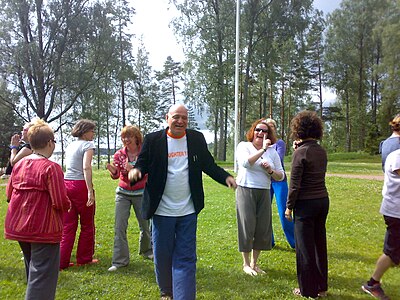Laughter yoga
From Wikipedia, the free encyclopedia
Laughter yoga (Hasyayoga) is a practice involving prolonged voluntary laughter. Laughter yoga is based on the belief that voluntary laughter provides the same physiological and psychological benefits as spontaneous laughter. Laughter yoga is done in groups, with eye contact and playfulness between participants. Forced laughter soon turns into real and contagious laughter.
History[edit]
Laughter yoga was made popular as an exercise routine developed by Indian physician Madan Kataria, who writes about the practice in his 2002 book Laugh For No Reason.[1]
In the mid-1990s, laughter yoga was practiced in the early mornings in open parks, primarily by groups of older people. Later, a more formal version was created and popularized as "Laughter Clubs". Kataria's first Laughter Yoga Club began on 13 March 1995 in Mumbai, with five people in a local public park.[2] The concept rapidly spread worldwide, and as of 2011, there were more than 8,000 Laughter Clubs in 100 countries.[3] Each group is run by a "Laugh Captain" and operates independently.
Method[edit]
Laughter is easily stimulated in a group when combined with eye contact, 'childlike playfulness' and laughter exercises. Fake laughter quickly becomes real. Laughter Yoga brings more oxygen to the body and brain by incorporating yogic breathing which results in deep diaphragmatic breathing.[4]
Anyone can laugh without needing to rely on humor, jokes or comedy. Laughter is initially simulated as a physical exercise while maintaining eye contact with others in the group and promoting childlike playfulness. In most cases this soon leads to real and contagious laughter. Laughter yoga is the only technique that allows adults to achieve sustained hearty laughter without involving cognitive thought.[5]
It bypasses the intellectual systems that normally act as a brake on natural laughter.
Laughter yoga sessions start with gentle warm-up techniques which include stretching, chanting, clapping and body movement. These help break down inhibitions and develop feelings of 'childlike playfulness'. Breathing exercises are used to prepare the lungs for laughter, followed by a series of ‘laughter exercises’ that combine the method of acting and visualization techniques with playfulness. These exercises, when combined with the strong social dynamics of group behavior, lead to prolonged and hearty unconditional laughter. Laughter exercises are interspersed with breathing exercises.[6] Twenty minutes of laughter is sufficient to develop full physiological benefits.
A laughter yoga session may finish with "Laughter Meditation". This is a session of unstructured laughter whereby participants sit or lie down and allow natural laughter to flow from within "like a fountain".[7]
Scientific validity[edit]
A handful of small-scale scientific studies have indicated that Laughter Yoga may potentially have some medically beneficial effects, including benefits to cardiovascular health and mood.[8] Benefits to mood in depressed patients have been found to be as good as exercise therapy.[9] A study by Oxford University found that pain thresholds become "significantly higher" after laughter, compared to the control condition, and saw this as being due to laughter itself, rather than the mood of the subject. The study suggested that Laughter produced an "endorphin-mediated opiate effect" which could "play a crucial role in social bonding".[10]

No hay comentarios:
Publicar un comentario